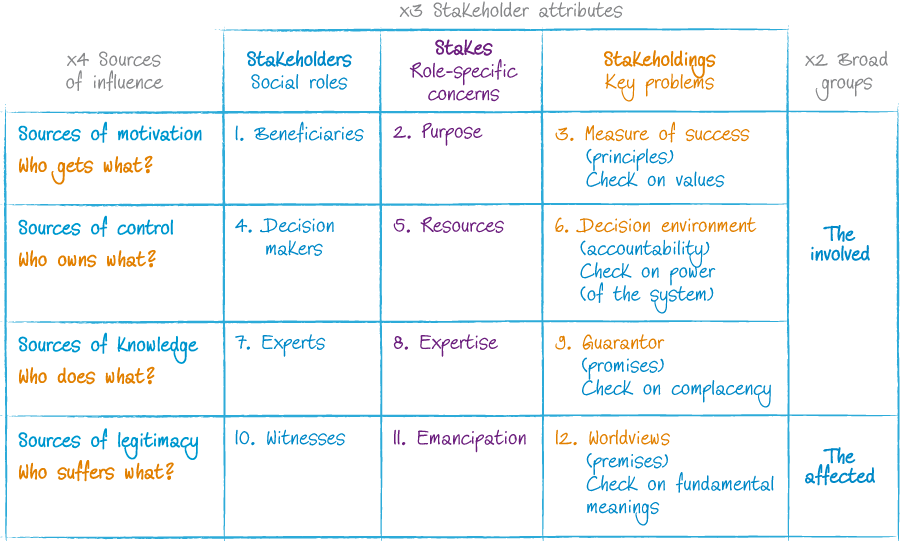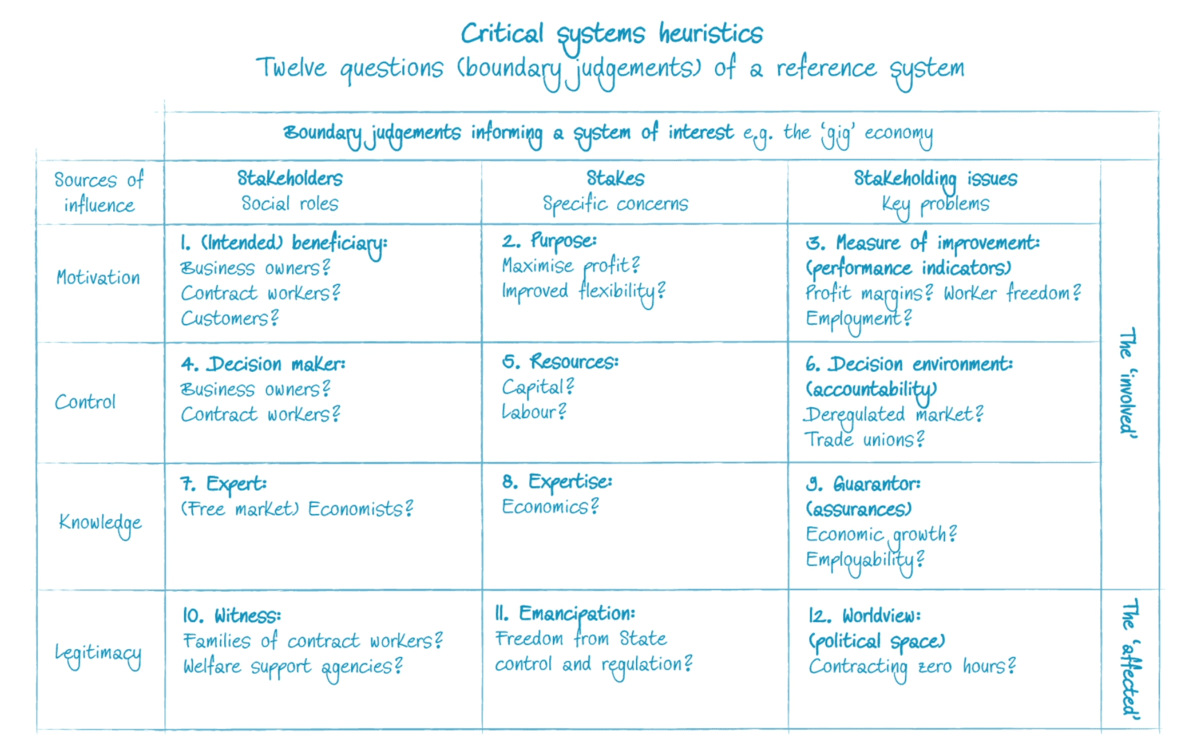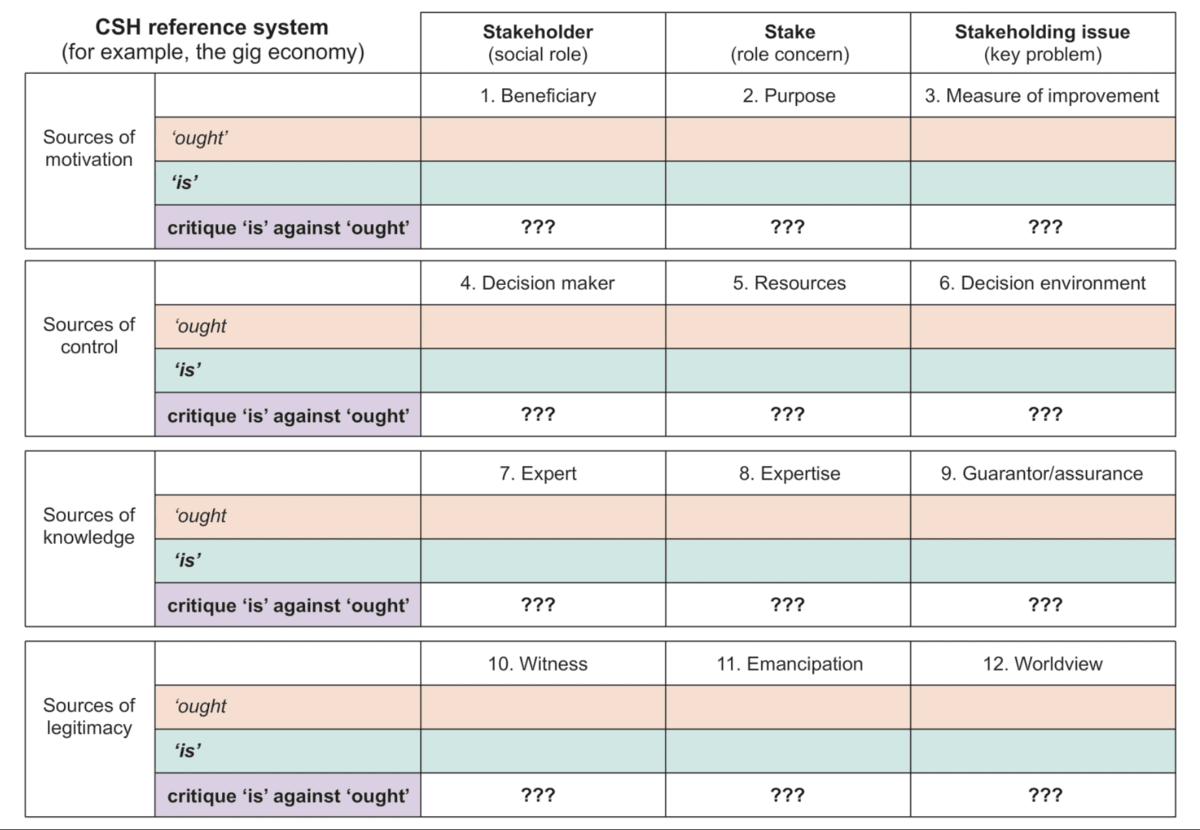TB871: Critical System Heuristics
Note: this is a post reflecting on one of the modules of my MSc in Systems Thinking in Practice. You can see all of the related posts in this category.
Critical Systems Heuristics (CSH) is a framework developed by Werner Ulrich in the 1980s, based on the work of C. West Churchman. It is a useful tool within the field of systems thinking that is particularly concerned with the ethical and political dimensions of decision-making and the boundaries within which those decisions are made. The approach is both reflective and discursive, offering a structured way to critically evaluate the assumptions and boundary judgments underlying any analysis or decision-making process.
CSH takes the form of a ‘reference system’ based on ‘boundary judgements’. These are arranged so that four sources of influence are mapped against three stakeholder attributes to make a 4×3 grid:
This all seems a bit abstract before you have a particular focus. The case study in the module materials is of the ‘gig economy’ — something which was presented originally as allowing for ‘market flexibility’ but which has proved to be a lot more problematic and nuanced than perhaps first envisaged. While laws have been brought in to limit the negative impact of ‘zero-hour contracts’ on workers in the EU and the UK, that is not true in other countries.
If I think about this from the point of view of my system of interest, ‘a system to support lifelong learning’ — which I’m conceptualising as being in a library setting — then we get something like the grid below. Note that the approach of ‘unfolding’ means going down row-by-row, starting with the ‘Stakes’ and moving to ‘Stakeholders’ before thinking about ‘Stakeholdings’.
| Sources of Influence | Stakeholders (Social roles) | Stakes (Specific concerns) | Stakeholdings (Key problems) | Groups |
|---|---|---|---|---|
| Sources of Motivation Who gets what? | 1. Library users (learners, researchers, borrowers, etc.) | 2. Purpose (to provide accessible lifelong learning resources) | 3. Measure of Success (engagement levels, learning outcomes) | The involved |
| Sources of Control Who owns what? | 4. Librarians (managers, staff, volunteers) | 5. Resources (books, digital content, facilities) | 6. Decision Environment (budget constraints, policy regulations) | The involved |
| Sources of Knowledge Who does what? | 7. Educational experts (curriculum designers, learning advisors) | 8. Expertise (educational resources, content curation) | 9. Guarantor (assurance of resource quality and relevance) | The involved |
| Sources of Legitimacy Who suffers what? | 10. Marginalised groups (people with limited access to education and opportunities) | 11. Emancipation (ensuring equitable access to space and resources) | 12. Worldview (commitment to inclusive education and lifelong learning) | The affected |
CSH is a technique for helping decide what is in scope, or to use systems thinking language, where to draw a boundary. There will always be a balance between who is included and excluded, and the idea with CSH is to provide a way to do so with “ethical and political astuteness” (The Open University, 2020c).
As with other approaches, CSH can be used in descriptive mode (i.e. ‘what is the situation?’) or in normative mode (i.e. ‘what ought to be the situation?’). This means that we can either focus on how we understand the actual reality surrounding an intervention, or on the characteristics an intervention ought to have in the ideal world (Ibid.).
The above example of ‘a system to support lifelong learning’ in a library setting is an example of using CSH in a normative way, as it is focusing on what ought to be the situation. We’re outlining the ideal characteristics that the system should have to meet the needs of all stakeholders effectively and ethically.
For example:
- The Stakeholders are identified based on their ideal roles in supporting lifelong learning (e.g., library users, librarians, educational experts)
- The Stakes outline the key concerns these stakeholders should ideally focus on to ensure the system supports lifelong learning effectively.
- The Stakeholdings column identifies the key problems or criteria that should be addressed to ensure the system functions optimally and equitably, reflecting the ideal characteristics of the system.
If we were to fill out the grid in a descriptive mode, the focus would shift to describing the current reality—what roles stakeholders currently play, what concerns they have in practice, and what the actual issues or challenges are within the existing system. The descriptions would be based on the current state of the system, rather than on an ideal or aspirational state.
Let’s have a go at how that grid might look different using a descriptive rather than normative approach, bearing in mind that I’m currently composing this post in the ‘study space’ of my local library. Not only does it have restricted opening hours, but it is taken over every Friday morning for a community event for older people.
| Sources of Influence | Stakeholders (Social Roles) | Stakes (Specific Concerns) | Stakeholdings (Key Problems) | Groups |
|---|---|---|---|---|
| Sources of Motivation Who gets what? |
1. Library (managers, council officials, administrators) | 2. Purpose: (increase library footfall and community engagement due to funding pressures) | 3. Measure of Success (measured by footfall and event participation, not necessarily by the quality of the study environment or educational outcomes) | The involved |
| Sources of Control Who owns what? |
4. Library staff, event organisers | 5. Resources: (limited space and budget constraints dictate how resources are allocated) | 6. Decision Environment (decisions are driven by the need to justify funding through high attendance figures, often at the cost of providing quiet study spaces) | The involved |
| Sources of Knowledge Who does what? |
7. Event coordinators, community engagement officers | 8. Expertise (focus on community outreach and event planning, with less emphasis on the needs of students and quiet learners) | 9. Guarantor (assurance of community engagement over the traditional library function of providing a conducive study environment) | The involved |
| Sources of Legitimacy Who suffers what? |
10. Library users, particularly students and quiet learners | 11. Emancipation (conflict arises between different user groups, such as elderly social groups vs. students needing study space) | 12. Worldview (the library is seen more as a community hub than a study space, which undermines its traditional role as a learning environment) | The affected |
We can then compare the normative and descriptive grids (“is versus ought”)
Applying this to my system of interest:
| Sources of Influence | Stakeholder (Social Role) | Stake (Role Concern) | Stakeholding Issue (Key Problem) |
|---|---|---|---|
| Sources of Motivation Who gets what? |
‘Ought’: Library users, especially students and learners who need quiet spaces | ‘Ought’: Provide equitable access to resources for lifelong learning | ‘Ought’: Success should be measured by learning outcomes and user satisfaction, not just footfall |
| ‘Is’: Library managers, council officials | ‘Is’: Increase library footfall and community engagement due to funding pressures | ‘Is’: Success is measured by footfall and event participation, not necessarily by the quality of the study environment or educational outcomes | |
| Critique ‘is’ against ‘ought’: Funding pressures have shifted focus away from educational outcomes to sheer numbers, which might not align with the library’s original purpose. | |||
| Sources of Control Who owns what? |
‘Ought’: Library staff should have the autonomy to allocate resources based on user needs, prioritizing study spaces | ‘Ought’: Resources should be allocated to balance community engagement with the needs of learners | ‘Ought’: Decisions should prioritize a quiet study environment and equitable resource distribution |
| ‘Is’: Library staff, event organisers | ‘Is’: Limited space and budget constraints dictate how resources are allocated | ‘Is’: Decisions are driven by the need to justify funding through high attendance figures, often at the cost of providing quiet study spaces | |
| Critique ‘is’ against ‘ought’: Resource allocation is currently driven by external pressures rather than the needs of all users, especially students. | |||
| Sources of Knowledge Who does what? |
‘Ought’: Educational experts should guide the library’s focus towards supporting lifelong learning | ‘Ought’: Expertise in educational resource management should be prioritized | ‘Ought’: Assurance of resource quality and relevance for lifelong learning should be a priority |
| ‘Is’: Event coordinators, community engagement officers | ‘Is’: Focus on community outreach and event planning, with less emphasis on the needs of students and quiet learners | ‘Is’: Assurance of community engagement over the traditional library function of providing a conducive study environment | |
| Critique ‘is’ against ‘ought’: The current focus on community events detracts from the library’s role in supporting educational activities. | |||
| Sources of Legitimacy Who suffers what? |
‘Ought’: Students and other quiet learners should have their needs met by the library’s environment | ‘Ought’: Ensure equitable access to quiet study spaces and resources | ‘Ought’: The library should be recognized as both a community hub and a place for learning, with balanced use of space |
| ‘Is’: Library users, particularly students and quiet learners | ‘Is’: Conflict arises between different user groups, such as elderly social groups vs. students needing study space | ‘Is’: The library is seen more as a community hub than a study space, which undermines its traditional role as a learning environment | |
| Critique ‘is’ against ‘ought’: The current environment fails to balance the needs of different user groups, leading to dissatisfaction among those who require a quiet study space. | |||
To round off this post, let’s summarise the three core features of CSH enquiry as reflective practice (The Open University, 2020d):
- Facilitating critical reflection: The enquiry process operates in two modes— a normative mode focused on what ought to be, involving value-based judgements, and a descriptive/analytical mode focused on what is, involving factual judgements. These modes interact to create an ongoing process of critique.
- Applying a specific systems concept: Both the normative and descriptive modes are framed by 12 boundary judgements, which define the limits of a CSH reference system. These judgements are structured around four sources of influence and three stakeholder attributes, all of which are interconnected to form a coherent system.
- Acting as a practical learning tool: The CSH reference system functions as a heuristic, or learning tool, by helping to understand the interrelationships within a situation of interest. It is also adaptable, allowing for adjustments in response to changing circumstances and diverse perspectives.
In my next post, I’ll compare and contrast CSH with the Soft System Methodology (SSM) in terms of how they deal with boundaries.
References
- The Open University (2020a) ‘6.1.1 An overview of CSH’, TB871 Block 6 Tools stream [Online]. Available at https://learn2.open.ac.uk/mod/oucontent/view.php?id=2261503§ion=2.1 (Accessed 16 August 2024).
- The Open University (2020b) ‘Block 6 Essential overview’, TB871 Block 6 Tools stream [Online]. Available at https://learn2.open.ac.uk/mod/oucontent/view.php?id=2261502 (Accessed 16 August 2024).
- The Open University (2020c) ‘6.1.2 Modelling with CSH’, TB871 Block 6 Tools stream [Online]. Available at https://learn2.open.ac.uk/mod/oucontent/view.php?id=2261503§ion=2.2 (Accessed 16 August 2024).
- The Open University (2020d) ‘6.1.3 Attributes of CSH’, TB871 Block 6 Tools stream [Online]. Available at https://learn2.open.ac.uk/mod/oucontent/view.php?id=2261503§ion=2.3 (Accessed 16 August 2024).



